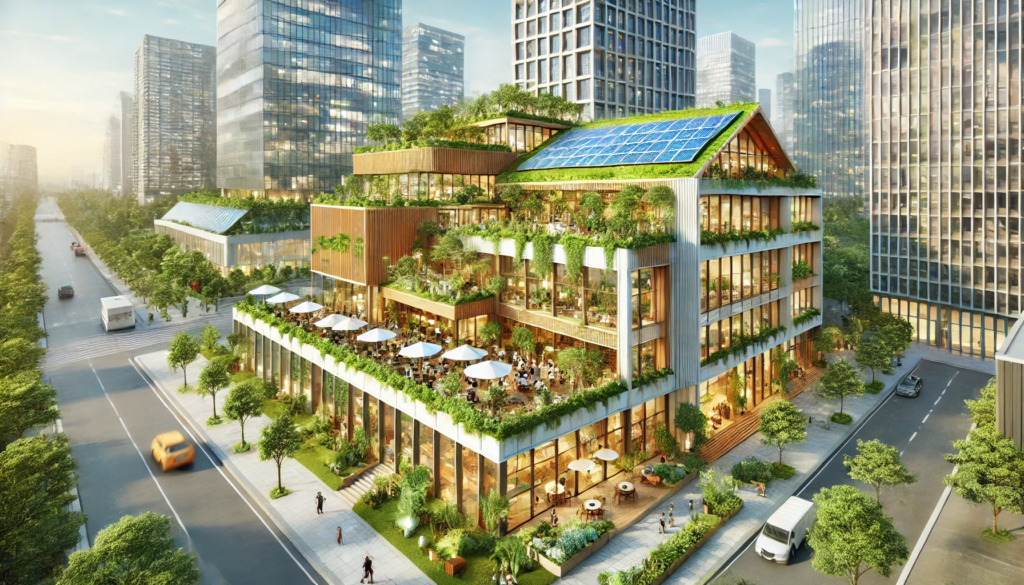The field of architecture is undergoing a transformative shift towards sustainability, driven by the urgent need to address environmental challenges and create healthier living spaces. Modern architects are increasingly integrating sustainable design principles into their projects.
1. Green Building Materials
Using eco-friendly materials is a cornerstone of sustainable design. Architects are turning to recycled, reclaimed, and renewable materials such as bamboo, reclaimed wood, recycled metal, and low-VOC (volatile organic compounds) paints. These materials reduce the environmental impact of construction and promote healthier indoor air quality.
2. Energy-Efficient Systems
Energy efficiency is a critical component of sustainable architecture. Modern buildings are equipped with advanced systems to minimize energy consumption. This includes the use of high-performance insulation, energy-efficient windows, LED lighting, and smart home technologies that optimize energy use. Additionally, renewable energy sources like solar panels and wind turbines are increasingly integrated into building designs to reduce reliance on fossil fuels.
3. Passive Design Strategies
Passive design involves using natural elements to regulate a building’s temperature and lighting. Techniques such as strategic window placement, thermal mass, natural ventilation, and shading devices help reduce the need for artificial heating, cooling, and lighting. This not only cuts energy costs but also creates a more comfortable and natural indoor environment.
4. Water Conservation in Sustainable Design
Water-efficient design is essential in sustainable architecture. Modern buildings incorporate rainwater harvesting systems, greywater recycling, low-flow fixtures, and drought-tolerant landscaping to minimize water usage. These strategies help conserve water resources and reduce the strain on municipal water systems.
5. Green Roofs and Walls
Green roofs and living walls are becoming popular features in sustainable buildings. These installations provide numerous benefits, including improved insulation, reduced urban heat island effect, enhanced biodiversity, and better air quality. They also create aesthetically pleasing spaces that connect occupants with nature.
6. Adaptive Reuse in Sustainable Design
Repurposing existing structures for new uses is a sustainable alternative to new construction. Adaptive reuse preserves the embodied energy of buildings, reduces waste, and maintains historical and cultural heritage. Architects are finding innovative ways to transform old factories, warehouses, and office buildings into modern residential, commercial, and mixed-use spaces.
7. Net-Zero Buildings
Net-zero buildings are designed to produce as much energy as they consume, resulting in a net-zero energy balance. Achieving this involves a combination of energy-efficient design, renewable energy generation, and energy storage systems. Net-zero buildings are a testament to the potential of sustainable design to drastically reduce the carbon footprint of the built environment.
8. Biophilic Design in Sustainable Design
Biophilic design emphasizes the human connection to nature by incorporating natural elements into the built environment. This includes the use of natural materials, ample natural light, indoor plants, and outdoor views. Biophilic design not only enhances the aesthetic appeal of spaces but also improves occupants’ well-being and productivity.
9. Modular and Prefabricated Construction
Modular and prefabricated construction methods are gaining traction for their sustainability benefits. These techniques involve manufacturing building components off-site in controlled environments, which reduces material waste, shortens construction timelines and enhances quality control.
10. Resilient Design in Sustainable Design
Resilient design focuses on creating buildings that can withstand and adapt to changing environmental conditions, such as extreme weather events and climate change. This includes designing for flood resistance, and seismic safety, and incorporating redundant systems to ensure building functionality during disruptions. Resilient design enhances the longevity and durability of buildings, making them more sustainable over time.
KlugKraft is the premier online destination for system integrators and interior designers to showcase their home & office automation products. This platform is meticulously crafted to highlight the synergy between innovative technology and elegant design. Providing a comprehensive portfolio space for professionals. KlugKraft allows experts to display their latest smart home technologies, from intuitive lighting solutions to sophisticated security systems, all designed to enhance modern living. By offering a dynamic and interactive showcase, KlugKraft not only connects these professionals with potential clients but also sets a new standard in the integration of technology and design in home automation, ensuring every space is as functional as it is visually stunning. KlugKraft (a unit of Smart Group)


